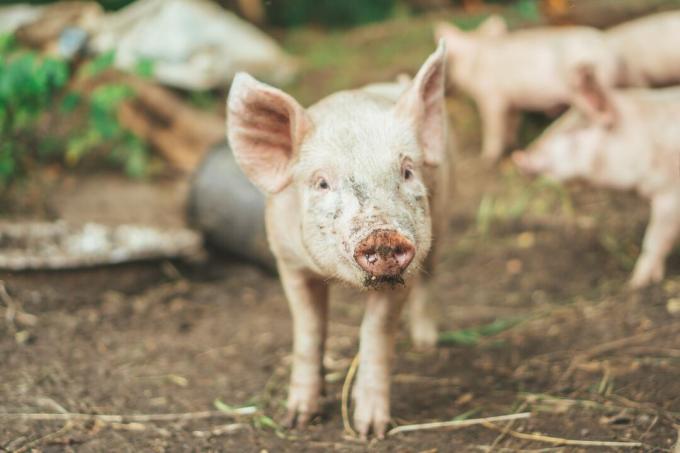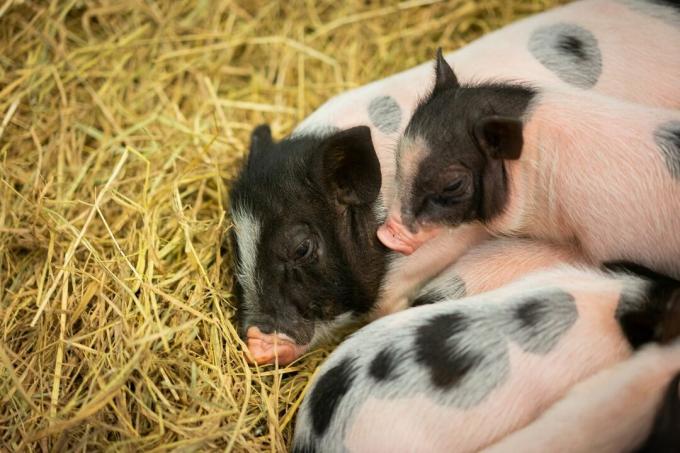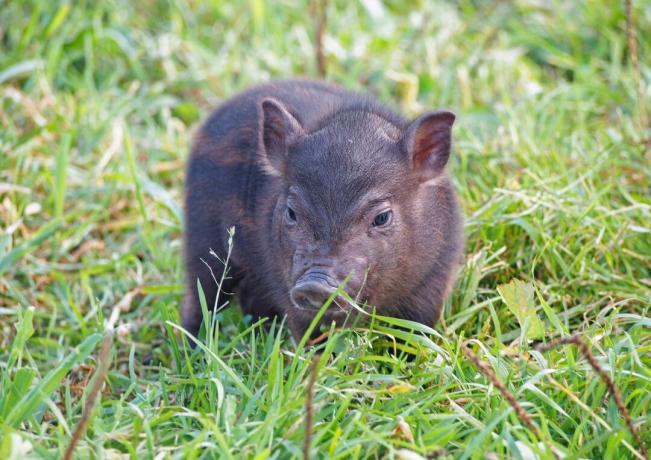More and more people are opting for the little pigs. You can find out here what you should consider when keeping mini pigs in the garden.

Cute, clever and sweet as candy - mini pigs are taking people's hearts by storm and are finding more and more lovers who are happy to offer them a home. The small domestic pigs have been bred since the 1940s and thanks to the growing interest in them, there are now numerous breeds and crossbreeds. In particular, their high level of intelligence predestines the little pigs as pets - with a little training, they can be trained well and can even learn tricks. In addition, mini pigs can build a strong connection to their caregiver and are particularly cuddly and affectionate. If you too have become curious about the miniature pigs, in this article you will learn how you can best keep the pigs and what else you need to consider when handling them.
contents
-
Keeping mini pigs in the garden
-
Why keep mini pigs in the garden?
- Challenges in keeping mini pigs in the garden
-
Properly keeping mini pigs in the garden
- Space and barn for mini pigs
- Nutrition of the mini pigs
- Employment and care of the mini pigs
- Bureaucracy when keeping mini pigs
-
Why keep mini pigs in the garden?
Keeping mini pigs in the garden
Whether as a pet or as a hard-working self-sufficient garden help, keeping mini pigs is becoming increasingly popular. The animals are particularly fond of being kept in the garden, because a basic requirement for keeping pigs is sufficient space for the intelligent animals. Anyone who can offer them this has good cards to successfully keep their mini pigs.
Why keep mini pigs in the garden?
If you want to have a pig as a pet, you quickly think of small, pink animals in handbag size that can easily be kept in the apartment. However, the animals are rarely suitable for keeping indoors: with an average shoulder height of 50 centimeters and Weighing up to 100 kilograms, the adult mini pigs are anything but delicate and can cause some damage in the house dish. So-called "teacup pigs", which are particularly delicate and small and often appear as pets on television are presented, however, are a rarity and often have health problems as a result of excessive breeding problems.
If you still want to give a mini pig a home, you should think about keeping it in the garden, because the robust animals feel particularly at home here, after all they have enough space to roam freely move. In fact, at least 100 square meters of exercise should be available for each pig - this is only possible in the rarest of cases in purely apartment housing. In addition, pigs are particularly curious and like to explore new terrain, which is why they are better off in a garden.

Challenges in keeping mini pigs in the garden
Mini pigs are cute, intelligent and cuddly - these arguments alone ensure that many people want such an animal to live in their garden. But even if keeping mini pigs in the garden is recommended, you should be aware that it also has disadvantages. Unlike dogs, cats or ducks, mini pigs leave clear tracks in their territory because they like to rummage through the ground with their trunks for something to eat. Lawns, flower beds or vegetable gardens quickly look like a battlefield when the pigs are free to romp in them - on An escape-proof outlet for the pigs is therefore the be-all and end-all if you continue to enjoy a pretty garden want. But not all plants are compatible with mini pigs. lily of the valley (Convallaria majalis), boxwood (Buxus sempervirens) or also the aerial part of potato plants (Solanum tuberosum) are absolutely poisonous for the pets and should therefore only be found within safe reach of the pigs or better avoided altogether.
Properly keeping mini pigs in the garden
So that mini pigs feel good, the right attitude in the garden is essential. Above all, you should take into account that mini pigs are very social animals that naturally live in packs. Keeping pigs individually is therefore not recommended, as the animals quickly develop behavioral problems and can even become ill. Other animals as company are not sufficient either - you should therefore always keep at least two, better three pigs together. In addition to the right company, the space and the right nutrition are also important for the well-being of the animals.
Space and barn for mini pigs
Even if mini pigs are not among the largest animals, they are not satisfied with a run in mini format. In fact, at least 100 square meters of exercise should be available per pig for species-appropriate husbandry, but there is no upper limit. Larger run-out areas have the additional advantage that individual areas can be cordoned off as required. This not only gives the vegetation time to recover from the little pigs' burrowing trunks, but also gives the new pets the opportunity to constantly explore new areas. Various surfaces within the run offer additional comfort: sand is ideal for lying down or wallows, lawns for playing and digging, and paved areas remain mud-free even when it rains.
tip: Thorough fencing is also important when running around in the garden: Your fence should be at least 80 to 100 centimeters high so that the pigs cannot escape. In addition, the fence should be particularly stable and anchored in the ground, since pigs, thanks to their great curiosity, also examine it or nibble on it. Due to the current threat to domestic pigs from African swine fever (ASF), the fencing regulations are currently being adjusted. Your local veterinary office will inform you about the currently applicable regulations. The regulations may vary between states. In principle, a double fence is always required - this is intended to prevent the mini pigs from having contact with wild boars and being infected with animal diseases such as ASF.

In addition to the run, the animals should have weather protection in the form of a stall or a dry shelter. This should have an area of at least four square meters per animal, at least one square meter per animal must be littered. The barn must also be well insulated in order to offer the pigs sufficient protection from the cold and wet in winter, but also a cool place in the shade in summer. The shelter should also be divided into different functional areas to increase the welfare of the pigs. This includes a soft, littered lying area, a (littered) toilet corner and a solid feeding area. The so-called Nürtinger system has proven particularly effective as a berth: around 130 centimeters are used within the stable tall resting boxes set up, closed and insulated on three sides and closed off on one side with plastic strip curtains are. This has the advantage that a normal outside temperature can prevail in the barn and does not have to be heated additionally, but the animals still find a warm resting place in the crates.

Nutrition of the mini pigs
Pigs are notoriously not too picky about their meals. Even mini pigs are no exception. The lively omnivores are characterized by a particularly good appetite and eat almost everything that comes under their noses. For this reason, it is particularly important to pay attention to a balanced diet for the sweet animals: pig feed, as in the Fattening is not suitable for mini pigs due to its high energy content, as they would otherwise quickly become fat would. Vegetables, bran, corn and a little fruit are better suited – meat, on the other hand, should not be fed as there is a risk of disease transmission.
Although pigs are wonderfully suited to making good use of vegetable waste such as potato peelings, caution is also required here: some foods that are compatible with humans, such as onions (Allium cepa), avocado (Persea americana) or cocoa (Theobroma cacao) are poisonous to pigs. In addition to the above-mentioned feedstuffs, there should always be enough grass or hay as basic feed, which, due to its low energy content, is not only excellent as a food, but also as an activity material suitable. Overall, the mini pig should have around 1 to 2% of its own body weight available as food. Of course, the mini pigs must always be supplied with fresh drinking water - pigs are not only true omnivores, they also drink large quantities.

Employment and care of the mini pigs
Mini pigs are particularly popular as pets because of their extremely cuddly nature and their very intelligent nature. Unfortunately, the animals quickly get bored if they don't have enough work. The first measures to entertain the animals can already be taken when designing the run: Piles of stones, brushwood or logs are structural elements that encourage movement and encourage natural curiosity the pigs. Toys such as ropes that can be pulled or balls also create a happy atmosphere.
But the pigs are also happy about attention from people - many pigs especially like to be petted or cleaned with the help of a root brush. This is not only for personal hygiene, but also strengthens the bond between the mini pigs and their owner. If you want to boost the intelligence of your pigs even more, you can resort to so-called clicker training: through positive ones Reinforcement can teach the clever animals all sorts of tricks and so both physically and mentally utilize.

Bureaucracy when keeping mini pigs
The purchase of a dog or a cat is usually associated with only a few bureaucratic hurdles - with the mini pig, on the other hand, the situation is very different. Since the small pigs are still among the livestock breeds, there are special requirements for keeping them - there are no exceptions for pure hobby keeping. For this reason, it is advisable to contact the responsible veterinary office before buying the first mini pig. This can provide more detailed information about bureaucratic processes, obligations as a pig farmer, but also local regulations, for example about infected areas.
Furthermore, the keeping of mini pigs must be reported to the competent authority, the animals must be marked and a stock register must be kept. In addition, mini pigs are to be reported to the Animal Disease Fund. If the animal owner suspects an epidemic in his animals, he is obliged to report this to report immediately, which requires knowledge of the most common pig diseases White. If he doesn't do this or if he doesn't register his pigs with the animal disease fund, he can be held liable with his private assets in the event of an outbreak.
If you are now further interested in keeping animals in the garden, you will find our article on keeping animals here Ducks versus snails.
...and receive concentrated plant knowledge and inspiration directly in your e-mail inbox every Sunday!
